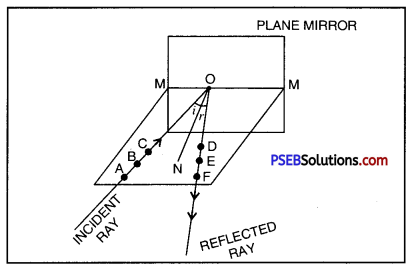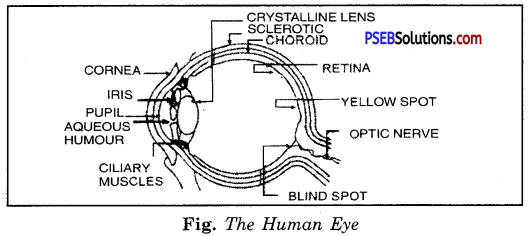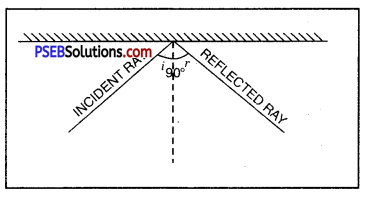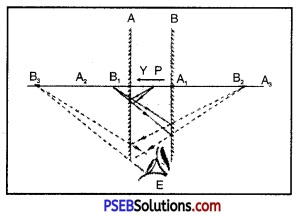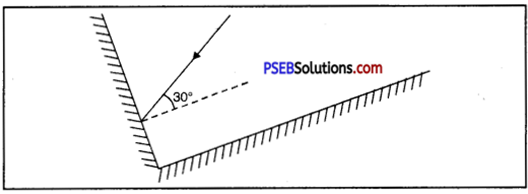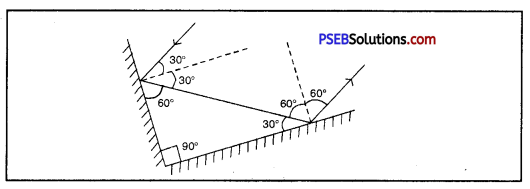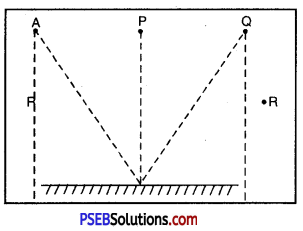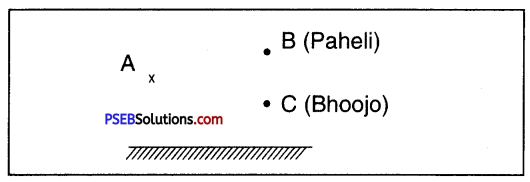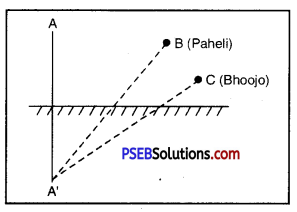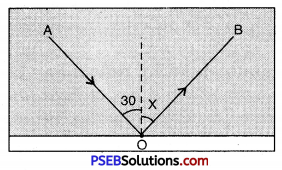Punjab State Board PSEB 8th Class Agriculture Book Solutions Chapter 10 Post Harvest Handling of Fruits and Vegetables Textbook Exercise Questions and Answers.
PSEB Solutions for Class 8 Agriculture Chapter 10 Post Harvest Handling of Fruits and Vegetables
Agriculture Guide for Class 8 PSEB Post Harvest Handling of Fruits and Vegetables Textbook Questions and Answers
(A) Answers in one or two words:
Question 1.
Which instrument is used to measure the firmness of fruits and vegetables?
Answer:
Penetrometer.
Question 2.
Which parameter is measured with a refractometer?
Answer:
The sweetness of fruit.
Question 3.
How much fruits and vegetables are lost before they reach markets?
Answer:
25-30%.

Question 4.
On which fruit the use of waxing is useful?
Answer:
Citrus fruits (Kinnow), apple and pears.
Question 5.
What is the storage temperature for potato and kinnow?
Answer:
For potato 1 to 2° C and for Kinnow 4 to 6°C
Question 6.
How much should be the relative humidity for storage of onkm?
Answer:
65-70%.

Question 7.
Which fruits are harvested on the basis of TSS and acid ratio?
Answer:
Grapes and citrus fruits, e.g. organge, Kinnow etc.
Question 8.
What precautions should be taken during transportation of produce?
Answer:
Vehicle should be padded or lined with straw. Heavy weight produce should not be loaded over the soft produce.
Question 9.
Name the harmful chemical used for ripening of fruit
Answer:
Calcium carbide.
Question 10.
Name the internationally acceptable technique used for ripening of fruits.
Answer:
Ripening by ethylene gas.

(B) Answer in one to two sentences:
Question 1.
On what basis fruits and vegetable are graded?
Answer:
Grading should be done as per the requirement of the market. Grading is done on the basis of size, weight, colour etc. This fetches more profit to the farmer.
Question 2.
Why produce should be cooled after harvest?
Answer:
Produce should be cooled immediately after harvesting. This helps in increasing the shelf life of the horticulture produce. Cold water or cold air can be used for this purpose.
Question 3.
What are the benefits of storage of fruits and vegetables?
Answer:
Produce is cheap in the season, and earning is less. If produce is preserved and sold in off season, it fetches more profit to the farmer.
Question 4.
What is the use of pentrometer and refractometer?
Answer:
Pentrometer is used to measure the firmness of the fruit and refractometer is used to measure the sweetness of the fruit.

Question 5.
How fruits and vegetables are graded on commercial scale?
Answer:
Fruits and vegetables are graded on commercial scale with the help of mechanical grader.
Question 6.
Which fruits are ripened with ethylene gas?
Answer:
Ripening by using ethylene is internationally accepted technique. Fruits like, banana, pears, tomato are ripened by this technique.
Question 7.
Which parameters should be taken into consideration for harvesting of tomato?
Answer:
Parameter that should be taken into consideration for harvesting of tomato is colour chart. For the nearby market red matured tomato, for medium distance markets at pink stage and for distant market harvesting at green stage should be done.
Question 8.
Which produce is packed in jute sacks?
Answer:
Potato and onion are packed in jute sacks.

Question 9.
Which wax is approved by FSSAI?
Answer:
FSSAI has approved shellak wax, camauba wax and bees wax.
Question 10.
What kind of boxes is used for the packaging of high-value produce?
Answer:
Corrugated fibre board boxes are used for the packing of high-value produce like, apple, mango, grapes, kinnow, peach, litchi, plum etc.
(C) Answers in five to six sentences:
Question 1.
What do you mean by waxing of fruits and what are its benefits?
Answer:
During marketing of the produce there is a loss of water contents which affect the natural gloss and quality of the produce. Fruits like, Kinnow, Peach etc. and vegetables like, Brinjal, Capsicum, Tomato, Cucumber etc. are waxed after harvesting. At the time of grading, washing or doing other preserving activities natural wax is removed. Rewaxing with food grade wax is done. Waxing helps in maintaining water content of the produce at the time of marketing. Dry the produce after waxing. Food grade waxes which is approved by FSSAI are shellac wax, bees wax, camauba wax.
Question 2.
Write a brief note on ripening of fruits with ethylene gas.
Answer:
Ripening of fruits at commercial level is done by using ethylene gas which is internationally accepted technique. In this technique fruits are kept in an enclosed chamber where the produce is exposed to 100-150 ppm of ethylene gas for 24 hours. This triggers the ripening process. Temperature should be maintained between 15 to 25 °C and humidity should be 90-95% ethylene gas is produced by using ethylene generator.

Question 3.
Write a short note on shrink and cling film packing of fruit.
Answer:
Fruits and vegetables are packed in a paper tray and wrapped with shrink or cling film.

The produce packed in this way remains visible to the cousumer and quality of the produce is also maintained. High value fruits and vegetables like kinnow, tomato, seedless cucumber etc. are packed using this technique. Farmer can earn good profit using this technique.
Question 4.
What is the importance of packging of fruits in corrugated fibre board boxes?
Answer:
For secure transportation of the fruits and vegetables, packaging proves beneficial, it is necessary to avoid bruising of produce during the transportation. Corrugated fibre board boxes are used for packaging of high value produce; like, apple, mango, grapes, kinnow, litchi, plums, peach etc. paper shreds or pieces of cardboard paper are also used in these boxes so that fruits do not get pressed against each other.

Question 5.
What precaution should be taken during harvesting of fruits and vegetables?
Answer:
Fruits and vegetables should be harvested carefully so that least damage to the produce takes place should be done manually with modesty. Take out the produce from the soil using hands use cloth laps open at both ends at the time of harvesting. Save produce from injuries. Use clip, knife and scissors for harvesting fruits. Take care that clipper and knife used are clean and sharp. Kinnow like fruits should be harvested with very small stalk with the fruit. If the stalk is long then at the time of transportation other fruits can get injuries. Use ladder for plucking Kinnow, pears, peach, alucha, ber, mango, etc.

PSEB 8th Class Agriculture Guide Post Harvest Handling of Fruits and Vegetables Important Questions and Answers
Very Short Answer Type Questions
Question 1.
According to WHO (World Health Organisation) how much fruits and vegetables should be consumed by a person in a day?
Answer:
300 gram vegetables and 80 gram fruits.
Question 2.
In India how much fruits and vegetables are available for a person per day?
Answer:
30 gram fruits and 80 gram vegetables.
Question 3.
How can we loiow about the maturity for harvesting of the tomato, mango, peach etc.?
Answer:
By using color chart.
Question 4.
What is the parameter for maturity of peachy?
Answer:
Turning from green color to yellow.

Question 5.
What is the parameter for maturity of guava?
Answer:
Turning deep green color to light green color.
Question 6.
What is the parameter for maturity of potato.
Answer:
Vines show sign of senescence (drying).
Question 7.
What is the parameter for maturity of plums?
Answer:
Reddish colour on 1/4 to 1/2 of surface.
Question 8.
What is parameter for maturity of bell Pepper?
Answer:
Fully developed fruit and green shining.
Question 9.
What is parameter for maturity of pea?
Answer:
Pods filled but not faded in colour.
Question 10.
What type of wax is coated on the fruits.
Answer:
Food grade wax like bees wax.

Question 11.
How is packaging of onion and potato in done?
Answer:
Using jute sacks.
Question 12.
For how many days kinnows can be stored in cold store?
Answer: 1 1/2 to 2 months.
Question 13.
How much moisture content should be in potato and kinnow at the time of storing in cold storage?
Answer:
90-95%.
Question 14.
What are the harmful effects of fruits ripened by calcium carbide?
Answer:
Blisters in mouth, ulcer, acidity in stomach.
Question 15.
For how much time fruits are exposed to ethylene gas in enclosed chamber?
Answer:
24 hours.
Question 16.
Name two fruits on which wax is coated?
Answer:
Kinnow, peach.

Question 17.
What is the maturity parameter for harvesting of fruits and vegetables.
Answer:
Size and colour- of these.
Question 18.
What instrument is used to measure the firmness of fruits?
Answer:
Pentrometer.
Question 19.
What is the relation between firmness and maturity?
Answer:
Mature fruit is less firm i,e. it becomes soft.
Question 20.
How to make fruits free from bacteria at home?
Answer:
Using bleaching soloution.
Question 21.
Which type of containers are used to store fruits?
Answer:
Containers should have plane inner surfaces.

Question 22.
What should be done to protect produce from injuries?
Answer:
Produce should be placed between layers of paper or cardboard.
Question 23.
What is the main purpose of canning?
Answer:
Main purpose of canning is to preserve the produce for a long time.
Question 24.
How grapes and Alucha should be cleaned?
Answer:
These should be cleaned using 100-150 ppm chlorine water. This way produce can be protected from diseases.
Question 25.
How grading is done for round shaped produce?
Answer:
These can be graded by using different sizes of rings.
Question 26.
Which chemicals are used to treat the produce after plucking?
Answer:
Calcium chloride, Sodium bisulphate, Potassium sulphate etc.
Question 27.
Name water tolerating crops.
Answer:
Carrot, tomato, turnip.

Question 28.
Which vegetables should not be washed before packing?
Answer:
Cabbage, Bhindi, peas.
Question 29.
Which fruits are graded on the basis of maturity?
Answer:
Tomato, Banana, Mango etc.
Short Answer Type Questions
Question 1.
How do we know the maturity of fruits? Describe in detail.
Answer:
Size of the fruits is a measure of their maturity. Mango is ready to be for harvesting when a beak appears on the fruit. For checking the ripening of tomato, peach, plums etc. coloured charts are used. For nearby market tomatoes should be red and for a distance market, these should be of pink colour but for very far away market full sized yet green tomatoes should be harvested.
Question 2.
How the hardness index of fruits be determined?
Answer:
Following method is used to determine the hardness index:
With the help of a sharp knife cut a thin slice. Slice is having pulp and skin of the fruit. Place the fruit on a plane hard surface and with the help of a proper sized plunger measure the hardness of the fruit. For this start pressing the fruit on the plunger with uniform speed. Measure the hardness index of the fruit from marks on the plunger.

Question 3.
What is Refractometer? For which fruits it is used?
Answer:
To measure the sweetness of the fruits refractometer is used. This is used for fruits like grapes, muskmelon etc.
Question 4.
How the acidity of the fruit is measured?
Answer:
When citrus fruits are ripe, there sourness decreases. To know the acidity, one or two drops of phenolphthalein are added to measured volume of fruit juice. In it add 0.1 N of sodium hydroxide solution drop by drop till the colour of juice changes to pink. From the used sodium hydroxide and given volume of juice, acidity of the juice can be measured.

Question 5.
How is ratio of percentage of sweetness and sourness is measured?
Answer:
By knowing this ratio quality of the fruit is judged. Percentage sweetness and sourness are measured and value of sweetness is divided by value of sourness to know the ratio.
Question 6.
What do you know about preservation to fruits?
Answer:
Every fruit is available in the market in a particular period of time of the year and it is available in plenty and it can be bought for comparatively less price. On these days fruits should be bought and preserved. More income can be earned by selling these in far away markets and by selling in off-season.
Question 7.
Why is it necessary to preserve vegetables?
Answer:
If vegetables are not preserved then more profit can not be earned, when vegetables are cheap in the season, buy and preserve the vegetables. These can be sold in off season and more profit can be earned.
Question 8.
How canning is profitable?
Answer:
By canning or packing, we can avoid the losses which may occur after plucking. This way more profit can be earned.
Question 9.
What is the use of Penetro meter?
Answer:
It is a device which is used to measure the hardness of the fruit.
Question 10.
Why is it necessary to (pluck kinnow with small stalk) keep the stalk short while plucking kinnow?
Answer:
If the stalk is long it can injure the other fruits while transportation. Thus kinnow are plucked or harvested with small stalks.

Question 11.
What is the importance of quality of crops?
Answer:
If quality is maintained then transportation, storage and marketing can be done for a long span of time and thus, more profit can be earned. This way consumer, exporter and trader all feel satisfied.
Long Answer Type Questions
Question 1.
What is the importance of plastic trays in {he preservation (storage) of fruits and vegetables?
Answer:
Plastic trays are costly, but these can be cleaned easily and used again and again. Air can pass through them because these have holes. These can be stacked over each other. At the time of harvesting, these prove very helpful. These can be used at time of harvesting, for storage, for transportation and for selling in the market. These trays are used for harvesting, storage and transportation of Kinnow, grapes, tomato etc.
Question 2.
What are merits of good quality produce?
Answer:
Following are the merits of good quality produce:
- This type of produce can be transported, marketed and stored for a longer time.
- This type of produce gives satisfaction to exporters, traders and consumers.
- Produce have long life after harvesting.
- Marketing sphere also grows big.
- More profit can be earned on selling such a produce.
Question 3.
What do you know about cooling, sorting and cleaning of the produce after harvesting?
Answer:
1. Cooling of the produce:
For long shelf life of the produce, it is allowed to cool down. The method of cooling depends on the type of produce. Different methods of cooling are with blowing cool air, cooling in a room, cooling with cold water. Any of the method can be used.
2. Sorting and cleaning of the produce:
Sorting and grading of the produce is done, injured, diseased and irregular shaped produce is separated out. Then it is cleaned, method of cleaning depends on the type of produce. Apples are cleaned using dry brushes whereas citrus fruits, carrots etc. are washed with water. Whether to use dry brushes or water for cleaning depends on the type of produce and extent of cleanliness, e.g. grapes and aluchas are never to be cleaned wash.
These fruits are made disease free by using 100-150 ppm chlorine water. Before packaging of cabbage and cauliflower etc., non eatable parts should be removed.

Question 4.
What do you know about grading and marketing of fruits and vegetables?
Answer:
Grading is done on the basis of size, weight, colour etc. Graded produce can earn more profit. Round fruits like tomato, tinda, apple etc. are graded using different sized rings. More profit can be earned if grading is done on the basis of maturity of produce like tomato, barihna, mango etc. Some type of machines on small scale can also be used for grading.
Fully grown but green tomato, mango etc. can be stored for sometime and when the rates in the market are on rise these can be ripened and sold to earn more profit. Green onion, mint, coriander leaves etc. are packed into bundles of 100 grams and 500 grams. This way these can be transported easily.
Question 5.
What do you know about the treatment of produce after harvesting?
Answer:
If produce is treated after harvesting it can be saved from various types of fungal diseases and many other diseases. Chemicals used for the treatment are potassium sulphate, sodiumbisulphite, calcium chloride etc. Some times produce is treated using hot water and blowing hot wind. This way germs are either killed or become weak and the produce is saved from disease. After the use of hot air or hot water, produce should be cooled down immediately by using showers of cold water or cold wind.
Question 6.
Which precautions should be kept in mind, while canning fruits and vegetables?
Answer:
Following precautions should be kept in mind while canning fruits and vegetables:
- Do not allow the produce to get injuries.
- Raw or more ripe fruits should be separated out.
- Do not wash green vegetables, cabbage, bhindi, tomato, etc. before canning.
- Chlorine used in water should not be more than 100-150 ppm.
- Water tolerant produce like tomato, carrot, turnip, etc. should be collected in the water-filled tank (chubacha).
- The table surface on which produce is washed, graded, or packed should be made smooth by placing sponge pieces at comers or edges or irregular points.
- Do not use restricted chemicals on the produce.
- Treat the produce after harvesting using proper methods like waxing, hot air, water, sulphar dioxide, etc.
- To lessen the damage, produce should be canned in the fields.
![]()
![]()
![]()
![]()



